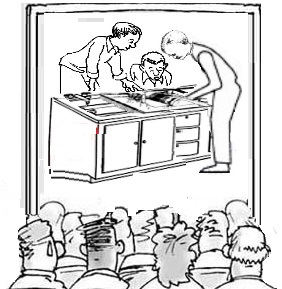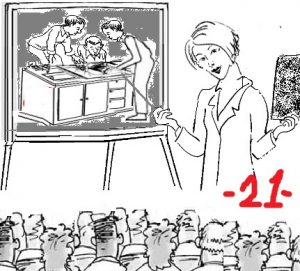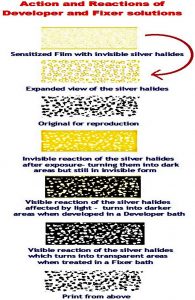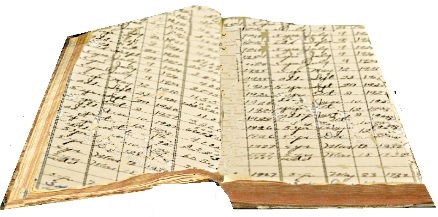
Guide to Printing Students – 21

-Few objective Questions and answers-

Written by : N.R. Jayaraman
Pre note:-
The articles are meant to help the students gain knowledge and effectively compete in the interviews and nothing else. Please note that these are not to be published by anyone for commercial purpose without the written permission from the author since the theme and illustrative examples have been compiled exclusively by the author for the benefit of the student community. THIS WILL BE PERIODICALLY PUBLISHED.
93) What is meant by Developing process for the films?
The films are coated with sensitive material incorporated with some group of Silver Halides that capture the images and hold with them with the help of suitable light source. The images are retained over the sensitive film in invisible form called latent image. During the process of developing which is carried with suitable chemical solution, the invisible latent image on film is converted into visible image.
Though the image has been captured on the film, it is not visible until the developer brings out the silver halides and convert them into black metallic silver that show the images on the film in reverse, i.e black areas in the image as transparent areas on film and white areas in the image into black areas. The developer solution is poured into a suitable tray to hold the film being developed and the exposed film immersed into the tray and tilted till the image on the film appears to the required level for further processing. This process of converting the invisible image into visible image is called Developing process.
Once the exposed film is developed, the brighter parts of the picture will appear as dark areas, while the darker parts of the picture will appear transparent in the developed Graphic arts process films while the black and white areas will be in the form of graduated tonal ones -from Black to greys of many hues- in the Photographic films.
94) What are the ingredients and qualities of the Developer solution?
The Developer solution consists of four groups of chemicals with certain properties. They are:
- ‘Developing agent’ which converts the silver halide crystals on the exposed areas of the film turn into black
- ‘Accelerator’ which activates the developing agents and ensure that sufficient alkaline content is maintained in the developer as the Developer solution is basically acidic in nature
- ‘Preservative’ to prevent rapid oxidation of the developer agent and finally
- ‘Restrainer’ to prevent unexposed silver halides from getting affected by developing agent.
The four groups of chemicals interact with each other and ensure that the developed film hold the required quality of the image for further reproduction process. The composition of the chemicals in the Developer solution differs in content and quantities to suit the specific types of film manufactured and supplied by different manufacturers. The Developing solutions also come as ready to use packs from the suppliers for the films to suit their films. Even though the manufacturers of the films recommend their own Developer solutions for the films they supply, it is found that some ready to use Developer is also found to work well with films of many manufacturers because the composition of the chemicals may react suitably with the sensitive coated material on those films.
95) Name some of the chemicals used in the Developer solution?
Some of the most commonly used chemicals in the Developing agent is Hydroquinone, Metol and Phenidone. In Preservative it is Sodium Sulphite; in Accelerator it is Sodium or Potassium Carbonate and in Restrainer it is Potassium Bromide.
The names of other chemicals used in the above four group are Elon, Phenidone, Dimezone, sodium hydroxide Paraphenylenediamine, and Borax etc. Though the manufacturer may indicate certain time period for developing a film, only with one’s own experience the extent of developing the film to get suitable tonal value of the image can be controlled.
96) What is Stop bath? Why is it necessary?
While the developer converts the latent image captured on the film into visible image within certain period of time say in seconds or minutes, the action of chemicals in the Developer continue to act on the film- i.e continuing to further blacken the exposed silver halides in the film beyond the quality of the image required for further processing which is referred to as over development. So, once the film has been developed to an appropriate degree, the film is treated with a solution called stop bath to hold the action of developer temporarily. The stop bath which is basically weaker acid mixed water arrests the action of the chemicals in the developer and puts a break on the continuing chemical action.
A common chemical used in stop baths is acetic acid. While the developer could also be washed off with water instead of subjecting them to acid stop bathing, use of acetic acid is both quicker and more effective in controlling action of the developer. If necessary, the stop bathed film after checking in dark room can be again put into the developer for few more minutes of developing to get required degree of image. Further, rinsing the film into mild or weaker acid solution ensure that the chemicals of the developer solution on the film is neutralized and does not contaminate the fixing solution which has a different composition. In this manner the life of the fixing solution that follows the development is enhanced.
97) Name the acids used in stop bath solution.
Universally only a weak Acetic acid is used in the stop bath since stronger acids such as Hydrochloric acid, Nitric acid, Sulphuric acid were also tried but found to cause precipitation in the fixer solution besides they were found injurious to hands causing irritation during processing.
98) What is meant by Fixing process for the films?
The film has sensitive coating with Silver Halides which form the invisible image and gets converted into visible image by the action of the chemicals in the developer. Only the reflected light from the objects or the image acts on the silver halides proportionately to the extent the light is reflected. Only those silver halides which are affected by the reflected light gets converted to black image on the film while the unaffected silver halides on the film retains its sensitivity and stay over the film intact. If the unaffected silver halides are not removed from the film, they will become dark again or foggy thus making the developed film unusable for further use. Therefore, the unaffected silver halides are to be removed from the film base. They can be removed and neutralized only with some chemical solution. The act of removing the unexposed silver halide is called Fixing process. The fixer solution stabilizes the image by removing the unexposed silver halide on the film thus leaving behind the light affected metallic silver that forms the image.
99) What are the components- chemicals- of a Fixer solution?
The fixer solution generally consist of :
- ‘Clearing agent’ such as sodium or ammonium thiosulfate both of which are also called Hypo which convert the unexposed, unaffected silver halide into soluble silver salts that gets dissolved in the fixer solution.
- In addition to the above some also add weaker acid in the fixer solution as neutralizer to arrest the continuing action of the residual developer carried to the fixer bath. Therefore in order to prolong the life of the fixing solution, some chemical like Sodium Sulphite is also added as ‘Preservative’.
- Finally in the name of ‘Hardening agent’ Aluminum Chloride or Potassium Alum is also added to reduce the swelling of the plasticizer or gelatin material which form the base of the film over which the sensitive coating has been given. During development process, the gelatin becomes softened and swells.

















Recent Comments